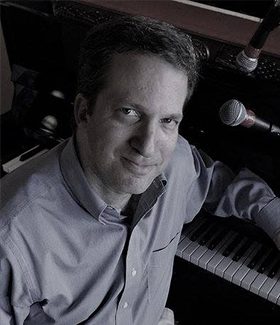Beethoven’s 250th Celebrated in Quad-Cities and Worldwide
Saturday In The Arts is a weekly look at a personality, place, trend or topic of interest to the Quad-Cities. It runs every Saturday morning on your site for fun, free, local entertainment and features, QuadCities.com.

Ludwig van Beethoven was not an easy person to like in real life, but 250 years after his birth, the monumental musical genius is easy to love and admire with a jaw-dropping sense of awe.
He’s a protean superhero who had to overcome so much adversity, and is being justly celebrated in the Quad-Cities and around the world.
The Quad City Symphony Orchestra titled this 2020-21 season “Ode to Joy,” and planned to launch its first Masterworks concert in October with the immortal Ninth Symphony (which includes the final choral movement with this ecstatic hymn to universal togetherness). Of course, Covid-19 forced major changes in the season, including shelving the Ninth and scaling back the size of QCSO forces, but not its devotion to honor the Beethoven anniversary.
It would have been a thrill to see the original October Masterworks (which would have required about 80 instrumentalists and at least 80 singers), paired with Jonathan Bailey Holland’s choral-orchestral “Ode” (2018), a 20-minute work commenting on the 70-minute Beethoven 9 with influences of rap, hip-hop and minimalism.
Mark Russell Smith, the QCSO’s enthusiastic, articulate music director and conductor, recently said Covid gave the orchestra new opportunities, such as programming specific Bela Bartok and J.S. Bach pieces for the first time in its 106-season history.
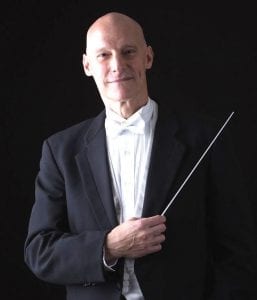
Mark Russell Smith
In October, the QCSO performed Beethoven’s smaller Symphony No. 1; in November it rescheduled the previously planned Violin Concerto (from December), showcasing the stellar concertmaster Naha Greenholtz, and newly substituted Beethoven’s groundbreaking Symphony No. 3 (“Eroica”) earlier this month. Each featured ensembles of fewer than 45 players.
After the two October concerts at the Adler Theatre, before limited live audiences, the QCSO went totally digital, performing the next two programs in an empty Adler – but like the first one, making the very professional video of each concert available online for $38 per household, for 30 days following the concert.
As a longtime musician myself (I studied at Oberlin College and Indiana University in the ‘80s), the videos are great and provide many varied camera angles, so you can experience the concert from the comfort of home in a way you never would in the concert hall.
I felt bad for the masked musicians, having to play for no one but themselves (in person), but that didn’t betray any lack of commitment or dedication – instead revealing fervent, emotionally satisfying performances with incredibly precise, dazzling technique and intense cohesion. They’re literally making history in addition to amazing, electrifying music.
Does it take away from the value of the performances, having an orchestra play without an in-person audience? I think on the contrary, it enhances their value, and shows the admirable commitment to the QCSO mission of bringing top-quality music to the community, despite all

Composer Jacob Bancks, who teaches at Augustana College, writes the QCSO program notes.
obstacles (kind of like Beethoven did, since many of his greatest works were penned while hard of hearing or completely deaf)
“I’m aware of what a lot of orchestras have done to cope with the pandemic and keep the music going, and I think the Quad City Symphony’s efforts have been as good as anybody’s,” Jacob Bancks, a composer at Augustana College and writer of QCSO’s program notes, said this week. “No one would ever claim that what we have now is superior to a live concert experience.
“I don’t think there’s anything that any orchestra could do, that could replace the intangibles of being in person,” he said. “It’s the resonance of the concert hall; it’s being in the same room as the musicians. There’s just no substitute for it. That said, I think the symphony has adopted a plan that’s very flexible – that puts the safety of its musician and audience first, and gives us something to keep us coming back.
“I wouldn’t say everything is lost, but there are many things about the glory of hearing music in person that’s obviously lost. But I don’t think anyone could have done a better job than the symphony has in keeping things going.”
QCSO executive director Brian Baxter said each digital production takes five people involved in filming and sound recording, though not all cameras (some giving views from above) are manned, and some are controlled remotely.
Digital access ticket sales have grown with each Masterworks, which Baxter likes to see.
“It is nowhere close to sales when we can have a full in-person audience for sure, but we’ve continued to hone the digital version of this product and we are seeing more people take advantage of it,” he said.
So what makes Beethoven so great?
Beethoven – one of very few classical composers known by name by the general public – was baptized Dec. 17, 1770 in Bonn, Germany, and was likely born the day before. I have unfairly claimed a link to the great man because our birthdays are so close (mine is Dec. 14), and he died in 1827 at the same age I am now (I don’t want that link) from post-hepatitic cirrhosis of the liver.
Bancks – who has had his original works premiered by the QCSO – said: “One of the things I love to bring out about Beethoven and his music is how his unique and very flawed personality gave birth to the music. We idolize Beethoven, which is not entirely wrong, because he was a manic genius. But at the same time, he was a very flawed being with a lot of personal problems.

Four depictions of Beethoven, imagined for today’s social media.
“He had a lot of difficulty keeping friends; in fact it’s a great testament to the character of the people he surrounded himself with, that he had any friends at the end of his life,” Bancks said.
A piece called “10 Things You Didn’t Know About Beethoven,” at www.dw.com, says:
“His chamber pot would remain unemptied under his piano and leftovers would be found scattered among his compositions. His face was stubby and pockmarked. This was Beethoven, too.
“The cheerful young composer turned into a grouchy and ill-tempered man. He wrote in the letter now known as the ‘Heiligenstadt Testament’ that his irritability was due to his increasing deafness. When Beethoven took custody of his nephew Karl after the death of his brother, he was so strict with him that the young man tried to commit suicide to escape his uncle’s grip.”
A new book, Laura Tunbridge’s Beethoven: A Life in Nine Pieces, notes that the lifelong bachelor (who was in love with certain women from afar) lived in 60 different apartments in Vienna, at times maintaining more than one at once. “From within the walls of these various stuffy, messy, less than hygienic dwellings, the world variously circled by or pressed in,” says a Guardian review.
“Complaints from the neighbors about noise, musical or verbal – he was famous for having explosive arguments with his servants – may in part explain his peripatetic habit.”
“At times the intrusion came from the political situation. He grumbled that the Napoleonic invasion of Vienna, with its ‘drums, cannons and human misery,’ had put a stop to his singing parties with friends.
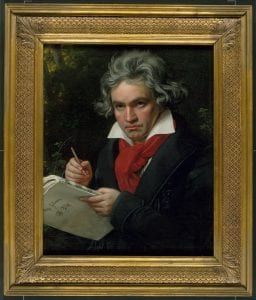
This famous portrait of Beethoven, by Joseph Karl Stieler, shows the composer at 49, seven years before his death.
In Tunbridge’s portrait, she “challenges, by example rather than theory, the presumption that Beethoven was curmudgeonly, friendless, loveless,” the review says. “Eccentric, yes, and with a canny knack at getting the best deals for his work, but a sympathetic figure too, frustrated by his ever-growing deafness.”
The Guardian says the new book is “different and welcome: a biography presented through the focus of nine different compositions, each casting light on aspects of Beethoven’s life, character and, given equal and readily comprehensible attention, the music. Her choices span early to late repertoire: from one of his first successes in Vienna, the Septet, to the Grosse Fuge, via Symphony No. 3 “Eroica,” the opera Fidelio, and the Missa Solemnis.”
In an essay about his popular piano piece “Fur Elise,” https://tonara.com/blog/history-of-fur-elise/, it notes that Beethoven was connected with several young women of the upper class, but none of them were able to look beyond his middle-class beginnings.
“Of course, his lack of decent hygiene was also a part of his failure to wed,” the piece says. “He had paid little attention to his appearance through most of his life, ignoring personal grooming and the condition of his clothes. He often just poured water over his head instead of washing, and his friends often took his clothes and had them cleaned while he slept, as he would go days and days in the same garments.
“And then
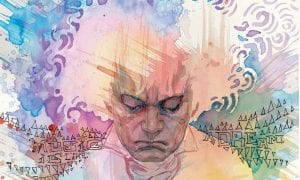
The cover of a new graphic novel about the legendary composer.
there was his personality. He would tell a person exactly what he felt, often to the point of rudeness. He was never willing to adjust his behavior to what society required; in fact, he always believed in his own musical genius and could not understand why the people around him didn’t always allow him to have his own way, rude and arrogant though he was. He seemed incapable of understanding the feelings of others, male or female.”
“He would idolize someone, and it wasn’t always a political figure or a famous person, but it was often someone within his circle of friends,” Bancks said. “He would put them up on a pedestal and as soon as they did something that disappointed him, they were out of his life and wouldn’t talk to them.”
The composer viewed his powerful contemporary, Napoleon Bonaparte, the same way – who Beethoven put up on a pedestal and ended up disappointing him. “The fact is, Beethoven’s work came from a very specific personality and he was a very powerful personality – but also very troubled.”
“I think his music lived up to an ideal that his life never could,” Bancks said. “I don’t want to paint him simply as a misanthrope. He was a misanthrope, but he could also be very loving and gregarious and if you catch him on the right day, he could be very kind. He was also extremely devoted to his family, to the point of taking his sister-in-law to court for custody of his nephew.”
“He just lived in extremes,” he said. “He was extremely loving and extremely spiteful, and extremely inspired, but also he had some duds of pieces. Like Bach – there’s not a note of Bach that was out of place…We have so much music from these composers that’s impeccable, but Beethoven, he had some stinkers, too. That, as a composer, I find very comforting. Even the greatest genius in our tradition had his off-days.”
In “Ludwig’s Lost Love,” Washington Post music critic Joseph McLellan wrote in 1995:
“Beethoven could be almost unbearable. When his youngest brother, Johann, moved in with a mistress in Linz, Beethoven denounced them and they leapt into a miserable marriage to avoid being arrested by the police. As the composer went deaf, he became paranoid; he was miserable to servants and friends.
“Go to Vienna and ask where Beethoven lived, and you will be given a choice of dozens of places — he was always on the move because of fights with landlords. He was devious in business, sometimes selling ‘exclusive’ rights to the same work to multiple publishers.”
To me, he appears both superhuman and an overwhelming, intimidating figure, but with tremendous insecurities and the sensitive soul of a poet and dreamer. He was the definition of tempestuous, tortured and troubled – a true Romantic.
Seeking and finding perfection
One thing Bancks loves about Beethoven is that he took musical genres and perfected them.
“We hear so many symphonies of his, but he did the same thing with the piano sonata and the string quartet that he did with the symphony,” he said. “What is beautiful about tracing his output is, you can listen to the first piano sonata and the 32nd piano sonata, and they’re all outstanding, and yet you can trace this incredible growth and deepening over the course of his career.”

Ludwig van Beethoven was baptized Dec. 17, 1770, likely born on Dec. 16.
Unlike fellow genius Mozart, one genre he didn’t master was opera, Bancks said, noting his one opera, “Fidelio” (1805 and revised twice). “It’s a very fine piece, but it was one and done with him,” he said. “He knew he didn’t have the energy to get right.”
“The human voice created a bit of frustration for him, because he couldn’t pin down what the range was and there were technical things,” he said. “His vocal writing is a little idealistic, but it’s gorgeous. It’s amazing, but I think it took more from him. As a vocal composer, he didn’t have the impact that Mozart did in opera, or Schubert or Schumann did in song.”
“Of course the Ninth Symphony is just out of this world,” Bancks said. “People forget that in his lifetime, he was not the most famous composer around. Haydn was phenomenally famous before him, and overlapping with his career. But Rossini was really the world’s most famous composer, and Rossini had a very different personality and a very different career – one much more oriented toward opera, and opera geared as a business, in a Hollywood style.”
Mozart (1756-1791) is such a singular case, since he was a prodigy, so prolific, new music seemed to flow so easily from him, and he only lived to be 35, Bancks said. “People speak about late Mozart, and I’m 38, but by the time he was my age, he was dead. He died at such an incredibly young age compared to Beethoven and compared to Rossini.”
“One of the things they had in common was their incredible facility as performers, especially as improvisers,” he said. “Half of Beethoven’s concert career was improvising…Then the composition came out of his improvisation.”
Wrestling with Beethoven’s long, drawn-out hearing loss, “it is absolutely amazing – I don’t want in any way want to take away from the fact that it’s like a miracle, that anyone could produce music of such high quality without actually being able to hear it,” Bancks said, noting two things contributed to that skill.
“He was a phenomenal keyboardist,” he said. “It’s ear and a muscle gift. His hands knew where to go. He knew his way around a keyboard. So, he had this muscle memory from when he was able to hear, that I’m sure he was able to rely on greatly after he was not able to hear his works performed.”
“One of my favorite things about Beethoven, the pretense for going to Vienna from his native Bonn was to study composition,” Bancks said. Beethoven studied piano with Joseph Haydn, vocal composition with Antonio Salieri (famous as Mozart’s rival in “Amadeus”) and counterpoint with a cathedral organist, Johann Albrechtsberger.
“There was rigorous training, the respect he had for the traditions of counterpoint,” Bancks said of Beethoven. “You have the fact that his hands knew what his ears couldn’t hear, and we go a little bit toward how that was possible. And the third thing was just a generational gift, like a supernatural gift for music. So those three things are all you need, and you too can compose deaf.”
Praising the composer’s revolution
In college (where I studied piano, music history and theory), I’d debate what one composer I’d choose to have their complete recorded works alone on a desert island, which is kind of apropos in quarantine. Especially, Mozart or Beethoven?
They both were super productive, geniuses, almost aliens, and wrote across many genres – symphonies, piano and violin solos, chamber music, concerti with orchestra, choral works and opera. (Key differences: Mozart wrote many operas, Beethoven only one, and Mozart left the unfinished Requiem; Beethoven didn’t write one.)

Mark Russell Smith in a Concert Conversations video.
Partly because of his highly-charged emotion, weight, and overpowering impressiveness, I would pick Beethoven. I also identified with his prickly personality – I am often grumpy, short-tempered, despondent, a mess, with bouts of lofty idealism and romantic flights of fancy. If only I could write music like that.
Smith, the QCSO maestro, said the composer is so important because broke the traditional bonds of music – and literally launched a new era, straddling like a colossus across the Classical and Romantic periods.
In the online “Concert Conversations,” Smith said of the 50-minute “Eroica” –
“It’s such a groundbreaking work, it’s a pivot point for Beethoven. He throws the shackles off; all bets are off. Codas get longer than development sections. The expression inherent in it just grows exponentially,” he said. “While still maintaining a relatively small orchestra, Beethoven just really pushes the limit of everything in Eroica. That’s what I wanted to show with this.
“And also have a big symphonic statement,” Smith said. “We weren’t able to do the Ninth Symphony, for obvious reasons. And the Eroica is a big symphonic statement, to put it mildly. What makes it more extraordinary, compared to everything else in Beethoven’s time, and compared to the First and Second Symphony, is just a huge thing. To be able to show that side of Beethoven, to show the evolution – and revolutionary Beethoven – in this context, Eroica is pretty much the one and only choice.”
“Just the massiveness of the structure leaves you after the first movement, like wiping your brow. Intensity and dissonance is new. To be shocked at it, as we should be, we have to put ourselves in the year 1806,” the conductor said.
“To us now, that we’ve been through Tchaikovsky and Stravinsky and everything, it doesn’t sound so shocking to our ears, but it absolutely is shocking,” Smith said. “Taking the forms that exist and breaking all the rules, and breaking the boundaries there, this is what it’s all about. It points us to where he goes for the rest of his artistic life.”
“What Beethoven is about is figuring out a way to finally express the inexpressible,” he said. “Mozart did that, but Mozart was like a perfector but not an innovator. So Mozart, in the operas and piano concerti, plumbs the depths but in a different way. And here’s Beethoven, making a
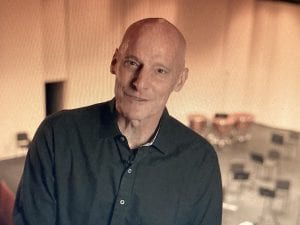
Mark Russell Smith offers an introduction during a QCSO digital access video.
statement.
“Mozart, I don’t believe, was trying to make a statement. But Beethoven – the full aesthetic of the artist making a comment or making something for the future, not just to put food on the table,” Smith said. “It’s taking a stand on something and expressing it. He was taking a stand on Bonaparte and freedom and heroism.”
The orchestral forms at the time couldn’t contain everything he had to say, the conductor noted.
“Letting the work just work its visceral magic,” Smith said. “It’s really a gutsy piece.”
Before the actual video performance, the conductor said: “If there’s ever a year when we need something to celebrate, this is the year.” Beethoven was a “man and a composer of the highest ideals,” he said. “He really was captured by the idea of Napoleon and freedom and liberation, and the liberal views that were going on in his hometown of Bonn.
“Napoleon turned out not to be the person he purported to be and when Napoleon made himself emperor, that soured Beethoven’s opinion, and Beethoven withdrew the dedication that originally came to the symphony,” Smith said of “Eroica.” “It was originally called ‘The

QCSO executive director Brian Baxter introduces November’s concert at the Adler.
Symphony to Bonaparte.’ He withdrew that quite angrily, and actually scratched out the dedication on the manuscript, and dedicated it to an unnamed hero.”
“This is the work where Beethoven starts to expand everything – expand expressive capabilities; expand the length of the symphony,” he said. “Now Beethoven is bursting at the seams. The first movement itself is longer than a Haydn symphony, so we not only expand the form, but we expand the expression, we expand the instrumental possibilities.”
Beethoven points in a new direction, to the Romantic era of classical music. “He sets the table for later works – the Fifth Symphony, the Sixth Symphony, and of course, the Ninth,” he said. “This is now a young Beethoven, who is absolutely bursting at the seams to express everything he has. We are so excited to bring this to you now, as a gift for the month of December, and as a tribute to Beethoven’s 250th birthday.”
The “Eroica” (paired with a Bach keyboard concerto, featuring pianist Marian Lee) is available online through Jan. 6, 2021, and the Violin Concerto (the only one Beethoven wrote) was up through Dec. 8.
Returning to a beloved concerto
“Beethoven himself was a great pianist and also played the viola, so he was a pretty accomplished string player,” Smith said, noting he wrote the concerto expressly for violinist Franz Clement, concertmaster of the Vienna orchestra, at the Theater an der Wien.
It was at a benefit concert of April 7, 1805 that Beethoven first publicly conducted his Eroica symphony, and in the same program Clement premiered his own violin concerto in D Major, one of Clement’s six known violin concertos.
He commissioned Beethoven’s Violin Concerto in D major from his friend for the next benefit concert, given on Dec. 23, 1806.
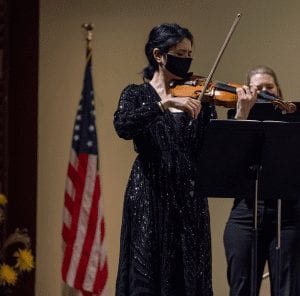
Greenholtz soloing during the Beethoven Violin Concerto in an empty Adler.
The last time Smith led the Beethoven Violin Concerto in Davenport was with the world-renowned Midori as soloist, in 2011. “I do have fond memories of that, I do,” he said. “I have lots of fond memories of this concerto. And a young Heifetz played it here in the Quad-Cities.
“Naha was like, ‘Yikes,’” Smith said. “It’s had some epic performances.”
The first QCSO performance of Beethoven’s violin concerto was in 1939, featuring none other than the legendary Jascha Heifetz, with Oscar Anderson conducting. It’s has been featured a total of seven times prior to 2020, notably for an Iowa Public Television broadcast with Miriam Fried in 1980.
Perhaps because he himself could not serve as soloist, Beethoven’s 1806 concerto did not enjoy the same early success that did his five piano concertos, according to QCSO program notes.
It initially had a mediocre audience reception, partly due to its length — it’s longer than Beethoven’s longest piano concerto. Whatever the reason, it wasn’t until 1844, nearly two decades after Beethoven’s death, that then-12-year-old violinist Joseph Joachim performed the work in London with Felix Mendelssohn conducting, bringing delayed acclaim and cementing the concerto in the repertoire, the QCSO program says.
The work did receive something of a special reception during Beethoven’s lifetime, not as a violin concerto, but in an arrangement for piano and orchestra, commissioned by pianist Muzio Clementi. Although Beethoven did not write his own cadenzas for the original violin concerto premiere, he did provide piano cadenzas for the Clementi version, which have since been re-arranged into violin cadenzas.
Greenholtz performed one of these arrangements for the first movement cadenza; her third-movement cadenza was composed by violinist Fritz Kreisler
Last month was the 12th time she has performed it.
“Personally, the concerto has been with me for a long time,” she said. “I started studying it in college…It requires a lot of emotional and
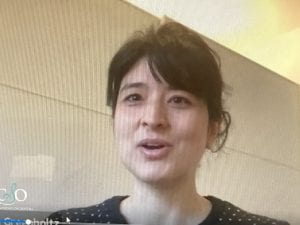
Greenholtz, also concertmaster of the Madison, Wis., orchestra, discusses Beethoven during the QCSO Concert Conversations.
musical maturity.”
“It feels like coming home,” Greenholtz said of playing it with the QCSO. “I love working with Mark; I have so much fun and respect for all the members of the Quad City Symphony. I’ve been here nine years now, and we just keep on getting better and the sound – the strings especially has evolved over the time since I’ve been here.
“It’s just a pleasure to keep coming back,” she said. “We keep strengthening the communication and the bonds, and now we have a musical history. That is a really nice thing.”
As a young player, the concerto was hard to grapple with and understand, Greenholtz said. Now she has a much better sense of control.
“What makes this piece unique, because of the role of the violin throughout the piece – especially in the first and second movements – that musical simplicity is a key aspect,” she said. “I think when you’re still working on your mastery of your own instrument, it’s hard to know if you’re soft enough, to trust in your own technique, you can really let the composer shine through. Trust that making simple musical lines is gonna carry.”
Smith said the hardest thing for classical musicians to do is be simple and affecting.
“For me, this is the huge challenge for the violin in this piece,” the conductor (who plays the cello) said. “There’s this incredibly florid obbligato that’s on top, that technically super hard to achieve – it’s way up in the stratosphere. It has to sound seamless; there are so many technical things that are so challenging, but the aesthetic has to be this beautiful, spinning, simple melody.”
“To create simplicity actually takes unbelievable virtuosity,” Smith said. She seamlessly achieves it, betraying little effort (which ironically
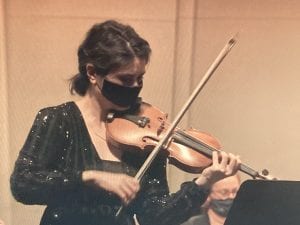
A closeup of Greenholtz, QCSO concertmaster, on the video made of the concert.
takes so much work in the first place).
With more obvious virtuosity, it’s easier to hide that as a distraction, Greenholtz said, agreeing simple is often harder.
Concert Conversations host Kai Swanson noted the 1802 Heilegenstadt Testament, a letter written by Beethoven, addressing his hearing loss. “He gets depressed for a while, but out comes this hopeful reflection, basically saying after all, life is worth living, so it’s very optimistic and upbeat,” he said. “Where does that figure in your approach to a piece?”
Smith said the late period (from 1815 on) was when Beethoven was completely deaf, which includes the Ninth Symphony, the Missa Solemnis and late string quartets. This middle period (starting in 1802) is when you get the 4th and 5th symphonies and Violin Concerto.
“He’s like he’s found his artistic stride,” Smith said. “He’s just composing like crazy, and composing monumental works like crazy. But that doesn’t mean they’re all the same. This work was written for Franz Clement, very specific to him.
“He’s a total famous virtuoso – certainly more famous than Beethoven was early on,” he said. “His violin technique is the kind of elegant, the singing expression, as opposed to the show-offy virtuosity…And Clement was definitely on the lyrical, gorgeous, musical side.”
“This concerto is more a reflection of Clement – the guy for whom it was written than a big strong statement,” he said. “He was making these statements. He wrote the Fifth and Sixth symphonies right next to each other, and they’re diametrically opposed pieces.”
The gentle Symphony No. 6 (the “Pastoral”) describes nature and rustic life, and the urgent Fifth is “where he’s shaking your fist against the heavens and major triumphs over minor and all that,” Smith said. “These are the same Beethoven, but totally different aesthetics. I think the same is true with this concerto. It’s reflective of the fruitfulness of that creative time, but also very much for the person it was written.”
Swanson noted during the 1918 flu pandemic, the then-Tri City Symphony cancelled its entire symphonic season, and just did concerts of trios and quintets.
“Here in the midst of this crisis, responsibly and I think, very safely, bringing the music together and presenting it live,” he said, noting the October 2020 Masterworks (with a small live audience) “was really overpowering for me, even watching on a little screen.”
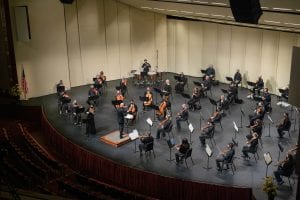
Naha Greenholtz performing the Violin Concerto with the Quad City Symphony in November 2020.
“It’s really something special,” Greenholtz said of first coming back together as an orchestra. “At the first rehearsal, I was a little bit worried. The spaces on the stage, that kind of felt oppressive – you really felt that room between you and the next violinist…It felt like forever for the information to come back to the front of the section. That very quickly turned around and it was really a special program.”
“I have many more cancelled concerts than things going on, so I am so, so grateful that we have these concerts in the Quad-Cities to look forward to, and to connect and make music for ourselves and everyone in the audience,” she said.
“The ovation we got at the beginning (in October), I honestly got choked up,” Smith said. “Like Naha and I looked at each other and like, wow. This is a very cool thing – to be embraced by the audience like that, you know. It was very special, and that just set the tone for the kind of specialness of the evening.
“The musicians were very gratified to be together and able to make music, but equally gratified by the audience and their embrace of us,” he said. “To know that you’re an integral part of the community, and that the community thinks so too. That’s what musicians want to be; they want our music, what we do, to be part and parcel to the identity of the Quad-Cities. Clearly, that’s the case, so that’s very gratifying.”
Crying out in isolation
The earth-shaking Heilgenstadt Testament is worth reading, and holds parallels to today’s sense of social isolation during our pandemic, and the importance of art.
In May 1802, Beethoven went to Heiligenstadt (an hour outside Vienna by carriage) to rest. In this letter to his two brothers, he railed against
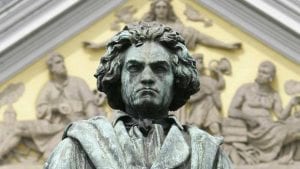
A stern statue of the man, who often was disagreeable in real life.
his oncoming deafness and treatment by others. If I was going deaf, I’d be profoundly pissed, too.
“O you men who think or say that that I am malevolent, stubborn or misanthropic, how greatly do you wrong me, you do not know the secret causes of my seeming, from childhood my heart and mind were disposed to the gentle feelings of good will, I was even ever eager to accomplish great deeds, but reflect now that for six years I have been a hopeless case, aggravated by senseless physicians, cheated year after year in the hope of improvement, finally compelled to face the prospect of a lasting malady (whose cure will take years or, perhaps, be impossible), born with an ardent and lively temperament, even susceptible to the diversions of society, I was compelled early to isolate myself, to live in loneliness, when I at times tried to forget all this, O how harshly was I repulsed by the doubly sad experience of my bad hearing, and yet it was impossible for me to say to men speak louder, shout, for I am deaf.
“Ah how could I possibly admit such an infirmity in the one sense which should have been more perfect in me than in others, a sense which I once possessed in highest perfection, a perfection such as few surely in my profession enjoy or have enjoyed — O I cannot do it, therefore forgive me when you see me draw back when I would gladly mingle with you, my misfortune is doubly painful because it must lead to my being misunderstood, for me there can be no recreations in society of my fellows, refined intercourse, mutual exchange of thought, only just as little as the greatest needs command may I mix with society, I must live like an exile, if I approach near to people a hot terror seizes upon me, a fear that I may be subjected to the danger of letting my condition be observed…
“ — thus it has been during the last half year which I spent in the country, commanded by my intelligent physician to spare my hearing as much as possible, in this almost meeting my present natural disposition, although I sometimes ran counter to it yielding to my inclination for society, but what a humiliation when one stood beside me and heard a flute in the distance and I heard nothing, or someone heard the shepherd singing and again I heard nothing, such incidents brought me to the verge of despair, but little more and I would have put an end to my life…
“ — only Art it was that withheld me, ah it seemed impossible to leave the world until I had produced all that I felt called upon me to
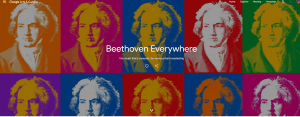
The home page of Google’s online project, “Beethoven Everywhere.”
produce, and so I endured this wretched existence — truly wretched, an excitable body which a sudden change can throw from the best into the worst state — Patience — it is said that I must now choose for my guide, I have done so, I hope my determination will remain firm to endure until it please the inexorable parcae to break the thread, perhaps I shall get better, perhaps not, I am prepared.”
What incredible patience and determination it must have taken him to keep writing music, while losing his hearing. Beethoven was completely deaf by age 44, but the exact cause was unknown.
“Theories range from syphilis to lead poisoning, typhus, or possibly even his habit of plunging his head into cold water to keep himself awake,” according to classicfm.com. “At one point he claimed he had suffered a fit of rage in 1798 when someone interrupted him at work.
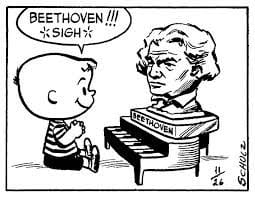
The immortal “Peanuts” comic showing a very young Schroeder and his musical hero.
Having fallen over, he said, he got up to find himself deaf. At other times he blamed it on gastrointestinal problems.”
At the premiere of the Ninth Symphony (the first time ever that a choir was part of a symphony) on May 7, 1824 in Vienna, the deaf composer conducted alongside the actual conductor, and had to be turned around at the mighty work’s triumphal end to see the rapturous audience reaction.
Violinist Joseph Böhm recalled at the time: “Beethoven himself conducted, that is, he stood in front of a conductor’s stand and threw himself back and forth like a madman. At one moment he stretched to his full height, at the next he crouched down to the floor, he flailed about with his hands and feet as though he wanted to play all the instruments and sing all the chorus parts.”
A fantastic link to the Ninth
Beethoven foreshadowed the feeling and form of that famous finale in one of my favorites of his, the Choral Fantasy, Op. 80, featuring piano solo, orchestra and choir. It also has a December anniversary, debuting Dec. 22, 1808 in a concert that also stunningly saw premieres of other greatest hits — the Fifth and Sixth Symphonies and the Fourth Piano Concerto as well as a performance of excerpts of the Mass in C major.
To conclude this memorable concert program, Beethoven wanted a brilliant finale that would unite in a single piece the different musical elements highlighted in the concert night. The Fantasia was composed precisely to fill that role, and Beethoven himself played the piano part and the opening solo offers an example of his improvisational style (at the premiere he did improvise this section).

The “Global Ode to Joy” posts tribute videos from around the world.
The work includes a sequence of variations on a theme that is widely felt to be an early version of a better-known variation theme, namely the one to which Beethoven set the words of Friedrich Schiller‘s “Ode to Joy” in his Ninth Symphony, according to a summary of the piece.
Beyond similar musical themes, there are also similarities in the texts of the two works, with the Choral Fantasy singing of universal fraternity with the meeting of arts. The composer himself apparently noted the connection between the Fantasy and the Ninth’s final movement.
In a letter of 1824, when he was writing the Ninth Symphony, he described his project as “a setting of the words of Schiller’s immortal ‘Lied an die Freude’ in the same way as my pianoforte fantasia with chorus, but on a far grander scale.”
The finale of Choral Fantasy is a triumphant ode to joy of another kind, and I freaking love it.
A description at Biography.com says “Beethoven is widely considered one of the greatest, if not the single greatest, composer of all time. Beethoven’s body of musical compositions stands with William Shakespeare‘s plays at the outer limits of human brilliance.
“And the fact Beethoven composed his most beautiful and extraordinary music while deaf is an almost superhuman feat of creative genius, perhaps only paralleled in the history of artistic achievement by John Milton writing Paradise Lost while blind.”
Celebrating worldwide, with his hometown, and new graphic novel
An official Beethoven 250th website, www.bthvn2020.de (you can use Google Translate for English), says: he “created musical universes and seminal works that burst the limits of human imagination in his day and left a lasting imprint on music history. He is fascinating proof that human creativity knows no bounds. He rebelled at any semblance of convention routine.
“He was an intellectual maverick and forward thinker who expanded the boundaries of music and constantly posed questions to society.

The cover of a new graphic novel about the legendary composer.
Several of his mightiest creations arose under conditions of increasing deafness.
“His radical artistry has made him an inspiration and role model for countless numbers of people,” the site says. “His music is visionary and reflects European society in a state of upheaval. It thus far transcends its original context and points the way to modernism. His works lend a voice to an unbridled will toward social change, loftiest humanism, freedom of the arts and social utopias, all of which have laid claim to universal validity to the present day. His music leads us to central questions of our identity and the future of our society.”
Google Arts & Culture has compiled a special online project in cooperation with the Beethoven-Haus in Bonn, which sheds light on the world of the iconic composer and lets users explore many facets of Beethoven’s life, work and legacy.
“250 years after his birth, Beethoven has more to tell us than ever,” according to the project. “Recurring themes like solidarity, hope, humanism, accessibility and the overcoming of obstacles in his life and music make for a strong contemporary significance.”
A central component of the project is a virtual tour of the composer’s birthplace in Bonn. “Due to the pandemic, our newly designed museum is closed on Beethoven’s 250th birthday,” said Malte Boecker, director of the Beethoven-Haus. “This makes it all the more important to me that Beethoven friends and music lovers from all over the world can now virtually visit the exhibition thanks to the Google Street View tour
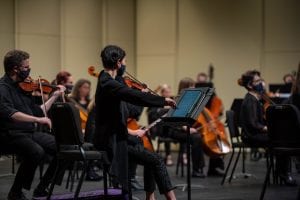
A Quad City Symphony violinist plays from an iPad in a recent concert.
and experience it with a lot of additional Beethoven content.”
Among the 18 cultural institutions from seven countries that have participated in “Beethoven Everywhere” are the Beethoven-Haus in Bonn, Carnegie Hall, Deutsche Grammophon, the Secession in Vienna, the Karajan Academy of the Berlin Philharmonic, and the Chineke! Orchestra from Great Britain.
A variety of stories, contributions and videos – created and curated by Beethoven experts – allow a global audience to learn more about his everyday life: How he worked, what made his music so groundbreaking and where we still encounter him in our modern culture today.
A central component of the online celebrations is also the video series “Global Ode to Joy,” initiated by conductor Marin Alsop, in which people around the world participate to celebrate the composer.
As one of the main partners, Beethoven-Haus Bonn has contributed more than 500 objects from its collection and created 25 online stories especially for the project. In addition to a tour through the museum using Google Street View, highlights to be discovered online include the legendary Beethoven portrait by Joseph Karl Stieler, personal items of Beethoven such as his instruments, desk, compass and hearing aids, as well as numerous autographs, letters, notes and scores.
“I am excited about the vast range of stories and formats that museums, orchestras and archives from all over the world collected on Google Arts & Culture, as they provide immediate insights into the life and work of the artist Ludwig van Beethoven and make his influence on our
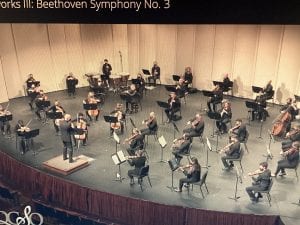
An image from the QCSO performing the “Eroica” Symphony Dec. 5. 2020.
modern culture impressively transparent,” said Simon Rein, program manager for Google Arts & Culture,
The entire Beethoven online exhibition can be found at https://artsandculture.google.com/project/beethoven, as well as via the free app on iOS or Android.
For the 250th birthday, join YouTube, Google Arts & Culture, and people around the world in a #GlobalOdeToJoy by making and sharing videos that inspire joy. Learn more at www.globalodetojoy.com.
“Because this year has been difficult and it’s important to share moments of joy whenever we can,” the site says. “With concert halls dark and performances canceled, the big celebratory concerts we expected are gone. And yet, we need his music — and message of unity and joy — more than ever.
“The Global Ode to Joy asks us to choose joy and share it with the world. With the help of our global partners, international artists, and you, we are collecting and sharing as many joy-filled videos as possible from now until Beethoven’s birthday in December.”
The best videos will be featured on Google Arts & Culture’s YouTube channel and in a grand finale video that will set the videos’ most joyful moments to Beethoven’s “Ode to Joy” chorus, with new lyrics from Pulitzer Prize–winning poet Tracy K. Smith.
Z2 Comics and Deutsche Grammophon also have a new Beethoven graphic novel, The Final Symphony: A Beethoven Anthology, released last month.
It reimagines the life of the legendary composer through striking new visuals created by world-class artists. The deluxe edition of the

A reduced QCSO string section plays while standing at the Adler.
Beethoven graphic novel is accompanied by an exclusive double album following the story through the composer’s own works.
“Beyond his prolific output Beethoven faced many struggles in his personal life, including tumultuous relationships and the loss of hearing which affected him profoundly, however his music is a testament to the human spirit in the face of cruel misfortune,” according to a release on the book.
“It is of course, incredibly exciting to publish the work of some of today’s well-known artists, but to have this chance to tell comic book stories from and inspired by the life of one of the most legendary artists of all time is humbling,” publisher Josh Frankel said. “We have done our very best to honor this by putting together what we believe will be an essential read for music lovers of all ages.”
Kleopatra Sofroniou of Deutsche Grammophon, added: “As one of the longest-standing record labels, Deutsche Grammophon has been celebrating Beethoven’s 250th anniversary this year with a number of projects, including the most comprehensive New Complete Edition of Beethoven’s works ever issued and wonderful new releases with stars like Anne-Sophie Mutter, Daniel Barenboim, Yo-Yo Ma and Rudolf Buchbinder.
“We are delighted to be encouraging the dialogue between the visual arts and classical music and hope that this exciting new project will open doors for comic book fans to discover the magic of Beethoven’s music.”
Listeners can enjoy Beethoven The New Complete Edition, the most comprehensive Beethoven anthology ever produced, created in partnership with the Beethoven-Haus Bonn, which includes over 175 hours of music on 123 discs and features over 250 of the greatest Beethoven performers.
From “Peanuts” to Billy Joel
Of course, far less highfalutin’ ways I’ve enjoyed Ludwig is through the toy-piano playing Schroeder from “Peanuts” and one of my favorite pop stars, Billy Joel.
Schroeder first appeared as a baby in the legendary comic in 1951 and initially, there was no specific reference to music, outside of his house number matching Beethoven’s birth year of 1770, according to https://91classical.org/post/the-good-grief-of-beethoven-on-schroeders-toy-piano-in-peanuts/.
After watching his daughter enjoy her toy piano, artist Charles Schulz decided to incorporate one into the story. Charlie Brown gamely
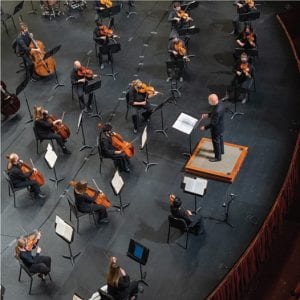
A view of the Quad City Symphony from above at Davenport’s Adler Theatre.
attempted to show Schroeder how to play. But when Schroeder sat down at the instrument, he was already a prodigy—playing music by Rachmaninoff.
Schulz was a well-known classical music fan, attending concerts regularly. According to his widow Jean Schulz, he could sit remarkably still for the entire show, rarely even fidgeting at all. The artist couldn’t read music, but wanted to honor Beethoven, so Schroeder idolized him.
“I think it’s important to try to break beneath the surface in everything you are doing, rather than just drawing surface cartoons,” Schulz said.
Interestingly, his favorite composer wasn’t Beethoven at all— it was Johannes Brahms, the 91classical.org piece says. “But, Schulz knew the comic value of a character like Beethoven.”
Schroeder was not the first to try and play Beethoven’s music in the comic strip. Charlie Brown, who frequently picked up and experimented with various musical instruments, makes a valiant attempt at Beethoven on the violin. Eventually, he stops after he has a dream in which Beethoven strangles him.
But it was Schroeder’s love of the composer— and his devotion to Beethoven’s music and legacy— that became iconic and inseparable from his character, the piece says. Not long after Schroeder appears, Charlie Brown drags a heavy box into the room, and delivers to the young pianist a bust of Beethoven. This moment could be pinpointed as the start of Schroeder’s true fanaticism for the composer.
I personally got to play Schroeder in a weird lip-synched version of the 1967 musical “You’re a Good Man, Charlie Brown” in grade school in the ‘70s. In that show, the opening of Beethoven’s iconic “Moonlight” Sonata is the accompaniment of Lucy’s song, “Schroeder.”

The immortal “Peanuts” comic showing a very young Schroeder and his musical hero.
And of course, there’s Beethoven’s getting a posthumous songwriting credit with Billy Joel in the nostalgic ballad “This Night,” on his 1983 album, “An Innocent Man.”
When Brett Mitchell, music director of the Colorado Symphony, was a teenager, he watched the 1990s Beethoven biopic “Immortal Beloved” (starring Gary Oldman) in the living room of his home in Seattle.
“And I asked my mother, ‘Why are they playing a Billy Joel song in the middle of a Beethoven movie?’” Mitchell recalled in July 2020 in this CPR Classical interview.
He was a Billy Joel fan as a teenager. He still is, he said. (SAME, Brett…)
That Beethoven “tune” in the movie was the slow movement of the Pathetique Sonata (1798), penned when he was just 27. To Mitchell, it sounded just like Joel’s song “This Night.”
In fact, Joel credits “L.v. Beethoven” as co-writer of the song, as the soaring chorus of the song is a direct “steal” from the melodious Pathetique.
Tune in to livestream birthday concert
A special jubilee concert on the actual Beethoven anniversary will be broadcast live from his hometown of Bonn, Germany on Dec. 17, 2020.
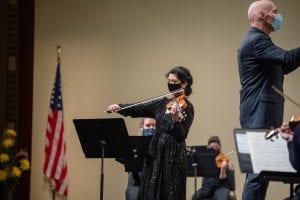
Naha Greenholtz performs the Beethoven Violin Concerto under the baton of QCSO conductor Mark Russell Smith.
The online livestream and television broadcasts will begin at 1:15 p.m. Central time, available at www.WDR.de or www.bthvn2020.de.
Pianist and conductor Daniel Barenboim and the West-Eastern Divan Orchestra will perform Beethoven’s Third Piano Concerto and his Symphony No. 5, also known as “Symphony of Fate.”
In the spirit of the anniversary celebrations, the anniversary concert also aims to set a social and political signal. The Symphony No. 5 in particular is intended to be a signal of hope in the year 2020, which has been devastated by Covid – claiming over 1.5 million lives worldwide.
As of Dec. 11, Covid-19 has caused 294,362 U.S. deaths (by far the most of any country), compared to 20,970 in Germany. While America has four times the population of Beethoven’s home nation, it has 14 times as many Covid fatalities.
The classic Fifth Symphony begins with tragic vehemence in C minor, but ends in radiant, triumphant C major, thus following the motto “per aspera ad astra,” – “from darkness to light,” according to https://west-eastern-divan.org/bonn-beethoven-broadcast.
In a dark time of year, during an extra dark year, we could use all the light we can get. For an ideal holiday gift, you can get QCSO digital access HERE.


